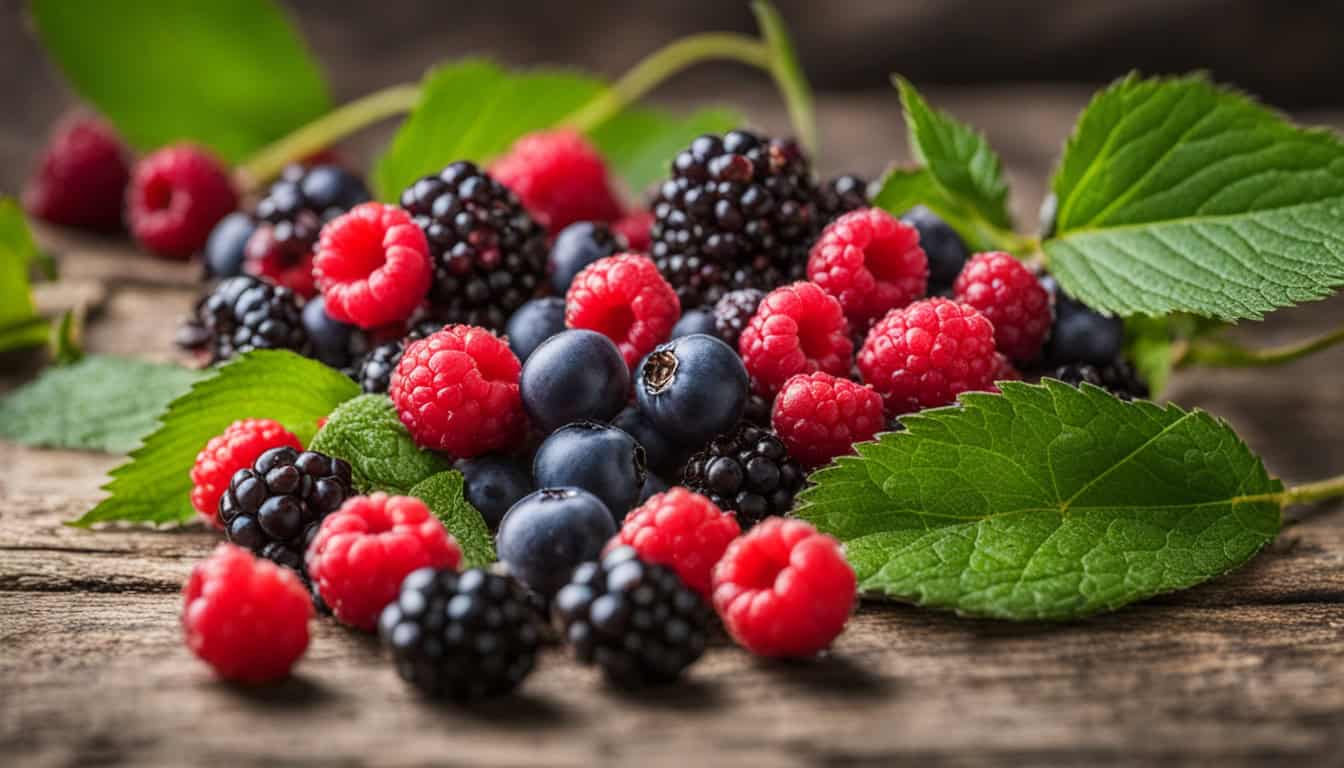Some wild berries are delicious, but others are toxic, making berry identification key. How can you tell the safe ones from the dangerous ones?
In the USA, wild berries come in many flavors and offer great nutrition. But, it’s vital to know how to pick them safely. Foragers can find a wide variety of berries, but without the right info, you might eat something harmful. Let’s look at the basics every forager should understand to enjoy nature’s bounty safely.
Introduction to Wild Berries in the USA
The United States is filled with North American berries waiting to be discovered. You can find everything from tasty, juicy treats to tangy, nutrient-rich gems. When picking wild berries, knowing which ones are safe to eat is super important.
Exploring the world of foraging means learning about the many wild berry types out there. In the USA, you’ll come across unique raspberries and well-known blueberries. Each kind has its special taste and health perks, making learning and picking all the more fun.
| Berry Type | Flavor Profile | Nutritional Benefits |
|---|---|---|
| Blueberries | Sweet and juicy | High in antioxidants and vitamins C and K |
| Raspberries | Tart and tangy | Rich in fiber and vitamin C |
| Blackberries | Sweet with a deep flavor | Loaded with vitamin C, vitamin K, and fiber |
Foraging for wild berries is more than a hobby; it connects you to nature and adds nutrition to your meals. By learning about North American berries, you help promote a sustainable way of living. So, grab your guide and embrace the adventure of finding and eating wild berries across the USA.
Elderberries
Elderberries are like a treasure waiting to be found. They come from the Sambucus plant. Knowing how to spot them and where they grow opens up a world of good food and health. They are packed with nutrients and taste great in many dishes.
Identification and Habitat
Identifying elderberries is easy once you know what to look for. Look for small, dark purple berries in clusters. They grow on shrubs or small trees and like moist places. You can find elderberries along forest edges, riverbanks, and in open fields across the U.S.
Nutritional Benefits
Elderberries are a great source of vitamin C. They boost your immune system to help you stay healthy. They also have antioxidants, which fight off stress in your body. Plus, they can help reduce inflammation, which is good for your health.
Culinary Uses
Elderberries are used in many recipes, from old to new. Cooking elderberries gets rid of their toxic parts, making them safe to eat. People use them to make jams, jellies, and syrups, and they’re a key ingredient in wines. They add flavor and nutrition to your meals. Explore elderberry recipes for a tasty and healthy twist to your food.
| Aspect | Description | Example Uses |
|---|---|---|
| Elderberries Identification | Small, dark purple berries in clusters | Used in foraging guides |
| Elderberry Habitat | Moist environments like riverbanks and forest edges | Found throughout the USA |
| Nutritional Benefits of Elderberries | Rich in vitamin C, antioxidants | Boosts immunity, reduces inflammation |
| Elderberry Recipes | Cooked applications including jams, syrups, and wines | Elderberry jam, elderberry wine |
Cloudberries
Cloudberries are a rare and prized berry. They are known as Rubus chamaemorus. These golden berries with their unique look and impressive nutrients grow in cold, wet areas of the Northern Hemisphere.
Identification and Habitat
Spotting cloudberries is thrilling for any forager. They are found in cold, boggy spots mainly in the Northern Hemisphere. Places like Scandinavia, Russia, Canada, and Alaska are home to these berries. Cloudberry plants are low-growing with beautiful white flowers. After these flowers bloom, the fruit, a golden-orange drupelet, emerges.
Health Benefits
Cloudberries are packed with health benefits. They have a lot of vitamin C which is great for your immune system. Cloudberries also have ellagitannins, making them powerful antioxidants. These antioxidants help reduce oxidative stress, promoting good health. Adding cloudberries to your diet can make you stronger and healthier.
“Cloudberries are not only a rare culinary delight but also a powerhouse of nutrients, offering significant health benefits for those fortunate enough to find them.”
Adding cloudberries to your meals is a great way to savor their unique taste and health perks. But, remember, finding these berries takes time and knowledge. Yet, the payoff is truly rewarding.
Huckleberries
Huckleberries are not just any berry. They have an interesting past and offer big health boosts. Found in the wilds of Northwestern America, they are loved not just for their bold color but also for what they give us.
Identification and Habitat
Huckleberries are small, round, and come in shades from red to deep purple. They love the mountain forests of Northwestern America. You’ll spot them in acidic soil under evergreen trees.
These berries are at their best in summer. They are packed with antioxidants. So, picking them is a favorite activity when they’re in season.
Antioxidant Properties
Huckleberries shine thanks to their high levels of anthocyanins and polyphenols. These make them great for fighting off inflammation and keeping your heart healthy. Adding huckleberries to your diet means embracing these health-boosting antioxidants.
| Nutrient | Benefit |
|---|---|
| Anthocyanins | Reduce inflammation |
| Polyphenols | Heart health support |
| Vitamin C | Immune system boost |
Gooseberries
Gooseberries are great for you and your taste buds. They bring lots of good flavors and healthy stuff to the table. You can find different kinds in Europe and America. This makes them perfect for trying new fruits.
Types and Habitat
There are lots of gooseberries out there, like European and American kinds. The European ones are bigger and come in colors like green, red, and purple. The American ones are smaller and mostly green. They grow best in cooler places like woodlands and gardens.
Nutritional Content
Gooseberries are packed with fiber, which is good for your tummy. They have a lot of vitamin C too, to help keep you healthy. You’ll also get vitamins A and B6 from them, plus minerals like potassium and manganese.
- High Fiber: Supports digestive health.
- Vitamin C: Enhances immune function.
- Minerals: Essential for various bodily functions.
Culinary Uses
There are so many ways to use gooseberries in the kitchen. Eat them fresh for a tangy treat. They’re also great for jams and pies because they’re high in pectin. Don’t forget, they can liven up your dinner too in sauces and chutneys.
| Type | Applications |
|---|---|
| Fresh | Snacks, Fruit Salads |
| Jams and Jellies | Preserves, Spreads |
| Savory Dishes | Sauces, Chutneys |
Chokeberries
Chokeberries, also known as Aronia berries, grow in Eastern North America. They are small, dark fruits that are full of good things for your body. They love different places and people are starting to love them for their health benefits.
Identification and Habitat
Hefty scrub shrubs bear chokeberries. These shrubs can be found in wet areas and dry, upland spots. Their round fruits are either black or red. They’re easy to spot by their shiny leaves and the white to pink flowers they have in spring. The fruit hangs around until late summer or early fall.
Health Benefits
Chokeberries have a lot of powerful stuff that’s good for you. They fight inflammation and help keep your cells safe. Thanks to their antioxidants, they’re like a shield for your body.
Vitamin K in these little fruits helps your blood clot and keeps your bones strong. They also have a lot of vitamin C and fiber. These things are all very good for you. Eating chokeberries is a smart choice for a healthy diet.
Culinary Uses
If you’re looking to boost your meals with health benefits, try chokeberries. They are perfect for making jams, juices, and wines because they are a bit sour. You can also put them in baked goods, smoothies, and salads.
Their taste works in a lot of different foods, from sweet to not so sweet. This makes them a great addition to a variety of dishes.
Mulberries
Mulberries enhance foraging trips in warm areas. Mulberry foraging unveils their goodness. They’re small healthful berries full of vitamins.
Loaded with iron and antioxidants, mulberries do wonders in your body. They’re versatile for every kitchen. There are endless mulberry uses to discover.
Enjoy mulberries fresh or in dishes like morning cereal. They make tasty desserts and jams too. Their sweet yet tart taste elevates any meal.
So, what’s the big deal with mulberries?
| Nutrient | Health Benefits |
|---|---|
| Iron | Supports healthy blood circulation |
| Antioxidants | Fights oxidative stress |
| Vitamins | Boosts immunity and overall health |
When in mulberry-rich places, gather some. They’re not just tasty; they’re incredibly nutritious. Use them in your recipes to enjoy and boost health.
Salmonberries
Salmonberries are a special kind of wild berry. You can find them in the forests of North America. Their color and taste make them very popular.
Identification and Habitat
Salmonberries are known by their bright orange to red colors. They have leaves with saw-like edges. You can find them in damp, forested areas near the Pacific coast.
They grow well under big trees. Knowing what they look like helps you find them safely.
Health Benefits
Salmonberries are packed with good things. They have manganese, vitamin C, and fiber. Eating them helps your body fight off sickness. They also keep your bones strong and protect you against harmful things.
Adding these berries to your meals can do a lot of good for your health. They taste great and make your dishes better.
Culinary Uses
These berries are not just healthy; they’re also fun to cook with. People use them to make jam, jelly, and other sweets. They add a sweet and tangy flavor.
You can also use them for making syrups and sauces. Or you could put them in drinks for a special flavor. There are many ways to use salmonberries in the kitchen.
In short, salmonberries are great for eating and cooking with. They’re a treasure for anyone who likes to find food in the wild.
Saskatoon Berries
Saskatoon berries are a favorite find during the summer. Also known as serviceberries, they are sweet and good for you. They grow across North America, especially in the northern states and Canada.

Identification and Habitat
Saskatoon berries stand out with their violet-blue shade and hint of almond. They grow on tall shrubs up to 15 feet. You’ll often see them in prairies, forests, and mountain areas. Their oval leaves with fine serrated edges are unique. This makes spotting them easy in the wild.
Nutritional Benefits
These berries are full of goodness. They offer fiber, antioxidants, and vitamins like C and riboflavin. These nutrients help with digestion, strengthen the immune system, and fight inflammation.
| Nutrient | Amount per 100g | Benefits |
|---|---|---|
| Fiber | 5.9g | Improves digestion |
| Vitamin C | 27mg | Boosts immune function |
| Riboflavin | 0.15mg | Supports energy metabolism |
| Antioxidants | – | Reduces inflammation |
Culinary Uses
Saskatoon berries can be used in a lot of fun recipes. You can make jellies, wines, pies, and breakfast treats with them. They add a sweet taste that goes well with many foods, whether salty or sweet. This is why they’re so popular in the kitchen.
You can make a tasty pie, some zesty jellies, or add their flavor to your wines. No matter what, these berries will spruce up your meals.
What Types of Wild Berries Are Safe to Eat in the USA?
Finding out the safe-to-eat wild berries is key when you’re foraging. The U.S. has many types with great flavors and nutrition. Start by learning to identify them safely.
Some well-known safe to eat wild berries are huckleberries, elderberries, and cloudberries. You can pick these in different parts of the U.S. and they’re good for you:
- Huckleberries – These grow mostly in the Northwest. They have a mix of sweet and sour and are very good for you, being rich in antioxidants.
- Elderberries – You’ll find elderberries in sunny spots. They are vitamin-packed and are commonly used in making jams and syrups.
- Cloudberries – Thriving in Northern bogs, the tart cloudberry is full of vitamin C and antioxidants.
The range of USA foraged berries means there’s something for everyone. Always take a detailed edible wild berries guide with you when you go foraging. It will help you tell the safe ones from the harmful ones.
Be very careful with safe wild berries. This not only makes foraging more fun, but it also keeps you healthy as you enjoy the outdoors.
Toxic Wild Berries to Avoid
While foraging for wild berries can be fun, it’s important to know many are unsafe. Poisonous berries like Virginia creepers, Pokeweed, and Deadly Nightshade are harmful. It’s crucial to learn how to spot these dangers.
Virginia creepers look like grapes but can irritate and upset your stomach. Pokeweed berries are green first, turning dark purple. Eating them may cause vomiting and make it hard to breathe. Deadly Nightshade’s black, glossy berries are toxic and can harm your nervous system. In severe cases, it can be deadly.
Knowing how to avoid toxic berries is vital for your safety and others’. Always carry a field guide or use an app to check if berries are safe. If you’re unsure, it’s best to skip picking them than risk getting sick.
FAQ
What types of wild berries are safe to eat in the USA?
In the USA, you can safely eat elderberries, cloudberries, and many more. It’s crucial to know them well before trying.
How can I identify edible wild berries in the USA?
To know which berries are okay to eat, look at their size, color, and where they grow. For help, use trusted guides or ask experts.
Where are elderberries commonly found and what do they look like?
Elderberries grow in moist, sunny spots. They are small, dark purple to black berries that come in bunches.
What are the nutritional benefits of elderberries?
Elderberries boost your immune system with vitamin C and antioxidants. They may help fight inflammation and keep your heart healthy too.
How can I use elderberries in cooking?
Use elderberries in jams, syrups, and wines after cooking them well. Never eat them raw because they can make you sick.
Where can cloudberries be found in the USA?
Cloudberries grow in peatlands of the Northern Hemisphere. You can find them in cold places, including some parts of Alaska.
What are the health benefits of cloudberries?
Cloudberries are a great source of vitamin C and antioxidants. They help keep you healthy by fighting inflammation.
How do I identify huckleberries?
Huckleberries are small, round berries found in red to blue. They grow best in the Northwest, especially in forests.
What antioxidant properties do huckleberries have?
Huckleberries have strong antioxidants from anthocyanins and polyphenols. These may ease inflammation and support your heart.
What types of gooseberries are edible in the USA?
In the USA, both European and American gooseberries are good to eat. You’ll find them in humid areas, in green, red, or purple colors.
What is the nutritional content of gooseberries?
Gooseberries are rich in fiber and vitamin C, making them healthy. They also have a bit of vitamin A and potassium.
How can gooseberries be used in culinary applications?
Eat gooseberries fresh or use them in desserts, jams, and sauces. They balance well with the sweetness in many dishes.
How do you identify and find chokeberries?
Chokeberries are small, black or red berries in Eastern North America. They grow in wet, sunny places in clusters on shrubs.
What are the health advantages of chokeberries?
Chokeberries offer vitamin K and antioxidants. These are good for your blood and they reduce stress in your body.
How can chokeberries be used in cooking?
Chokeberries work well in jams, juices, and even wine. You can also bake them into all sorts of treats.
Where do mulberries grow, and why are they beneficial?
Mulberries grow in warm parts across the US and are very good for you. They offer iron, vitamins, and antioxidants for health.
What are the identifying features of salmonberries?
Salmonberries are bright orange to red and look like raspberries. Find them in North American coastal forests.
What are the health benefits of salmonberries?
Salmonberries boost your immune system and help your bones with vitamin C and manganese. They are healthy and tasty.
How are salmonberries used in culinary dishes?
Use salmonberries in jams, sweets, and even in main courses. They bring a unique flavor to many dishes.
What makes Saskatoon berries unique?
Saskatoon berries are from North America and taste sweet. They are packed with riboflavin, which is good for your health.
How can Saskatoon berries be used in the kitchen?
Use Saskatoon berries in jellies, wines, and baked goods. They are a special part of many recipes.
What types of wild berries are safe to eat in the USA?
In the USA, you can eat many wild berries like elderberries and huckleberries. But it’s very important to know them before picking and eating.
What are some toxic wild berries to avoid in the USA?
Stay away from toxic berries like Virginia creeper and Deadly Nightshade. Knowing the good from the bad is key to staying safe.







